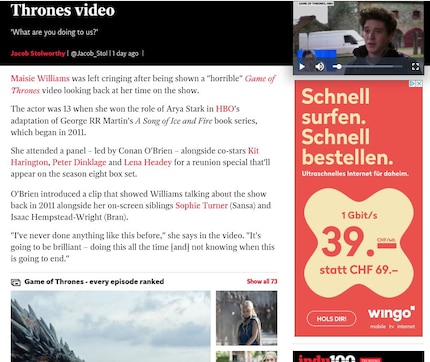
Guide
Apple iOS 14 Beta: how YouTube manages Picture-in-Picture
by Dominik Bärlocher

They say the Internet’s driven by advertisements. I say that’s rubbish. We could make do without. And not at the expense of good content.
I've had enough. It's time to violate terms of use and other nonsense that’s thrown at us by large, soulless companies. The self-proclaimed experts in advertising and web design are obviously not doing much about it. They must be too caught up in their ongoing mission «to strive to create a user experience that is as pleasant as possible» to make their websites halfway palatable. So for the time being, it’s up to us.
Let's take back our Internet. It’s high time.
The Independent is not a newspaper with a website such as NZZ. Nor is it a website with a newspaper such as 20min. The website itself is the newspaper and has been ever since the serious tabloid discontinued its print edition in 2016.
Here’s the problem: this is what the article about Maisie Williams and her funny bloopers on set looked like.
What I end up with is one lousy sentence on an entire screen. Let’s deduct the header and categorise everything as either advertising or content. We’re feeling generous so we’re counting any white space as content. Yet still, we’re left with a tragic result.
This results in 18.47% content versus 81.53% advertising. If we count the header as content, the result is slightly less depressing and makes for 30.84% of the screen.
Observant readers will have noticed that The Independent is not satisfied with 81.53% advertisements. The sleeping man is superimposing Swiss Post’s ad and Arc'teryx is partially covering Western Union’s ad.
What the?!
We’ll get to desktop PCs and Macs later. The main problem is smartphones. A great invention that makes me think things like «Hmmm… Maisie Williams says stuff. Let me take a look at that.» on my bus ride to work in the morning. Even if it leaves me none the wiser.
But there’s a simple solution. Resourceful developers got their hands on Chromium, the open version of Google Chrome, and installed a fixed adblocker.
For Android and Apple iOS – i.e. iPhones and iPads – as well as for PCs and Macs, there is Brave. This browser is fierce competition for the really big names. Why? Because it works similarly on all devices.
The result:
What’s more, Brave offers a handful of other privacy tools that give you a bit of extra freedom on the net. Not anonymity, however. Just because you're not being tracked by the browser doesn't mean you’re going undetected. But still, Brave is a great thing.
For Android there’s the Kiwi Browser,. Not only does it feature a really good adblocker, it can also force a dark mode on websites. This feature started to work quite reliably a few versions ago. And now, you get to surf in the dark.
The Kiwi Browser is coded in Estonia and offers settings that other browsers can only dream of. You’re in charge of which ads you want to see and when you want to see them. What’s more, you can install extensions from the Chrome Webstore.
Yvan Monneron and his crew in Chamonix had the idea to create a private browser for iPhones. The result is SnowHaze. It’s my browser of choice for iPhones as it offers a variety of settings to protect your privacy. Control cookies, JavaScript, HTTPS Enforcing and more by clicking on the cogwheel in the lower right corner.
The icing on the cake is that SnowHaze also features dark mode. Admittedly, it takes a bit of getting used to, but it's functional.
Yvan and his cronies make money with the SnowHaze VPN. This means they can offer the browser for free. The VPN is integrated into the app, which further simplifies its use.
Ads are not just an annoyance on your mobile but also on your desktop PC. If you're still using Internet Explorer or Edge, you’re best advised to get a browser that lets you upgrade to an adblocker. Firefox and Google Chrome are the two options.
If you’re using Edge, The Independent looks as follows:
Wingo can kiss my you-know-what. Because no matter how amazing their rates are, I really just wanted to read about Maisie Williams and nothing else. No flashing, animated advertisements.
Google Chrome has its own Web Store with a variety of adblockers on offer. Every now and then, somebody cries wolf or «virus» when it comes to adblockers. But I’ve never experienced any problems with the following setup I’ve been using for years:
This is what Maisie's embarrassing adventure looks like with the aforementioned setup:
Looks good to me.
Firefox also has a wide range of add ons. One of them being Adblocker Ultimate. This one solves your problem for good.
Looks the same as Chrome. Perfect.
Brave is miles ahead of the two big browsers. If you install Brave the browser will block ads by default. Incidentally, this also works at the office, even if you’re not the administrator.
And there’s more! Brave bypasses most adblocker blockers with no problem whatsoever. The thing is that some websites can't be read if you’ve installed an adblocker. So you must either put the site on your whitelist or deactivate the adblocker completely.
No thanks.
Brave also blocks that video that started all on its own.
The Internet relies on advertising, they say. Advertising promotes an open dialogue and freedom on the Internet. Advertising keeps your favourite Youtube Creators above water. Advertising is the only thing that’s keeping your favourite magazine going.
Bullshit.
You know what’s keeping your favourite magazine and your favourite YouTube channel going? Money. Not a pop-up or two commercials that are played before the YouTube video you wanted to watch. Just money. The stuff that’s in your wallet. Or in your account.
Or do what Republik has done. The magazine will give you a 14-day trial subscription in return for your e-mail address. By the way, this mechanism is easy to bypass. After that trial period, Republik costs 240 francs a year, but remains ad-free and open. Nice!
In short: an ad-free Internet is possible. You just have to want it.
Journalist. Author. Hacker. A storyteller searching for boundaries, secrets and taboos – putting the world to paper. Not because I can but because I can’t not.
Practical solutions for everyday problems with technology, household hacks and much more.
Show allIt all kicked off over something trivial. My newsfeed is doing as it should and shows me a news story. It's about actress Maisie Williams, who’s looking back on her time as Arya Stark in the hit series «Game of Thrones» in an entertaining panel. The article was published in the English online newspaper The Independent.

The cheek! How much of the screen is information and how much is advertising? I'm not interested in Swiss Post’s latest hogwash. I want to read about Winterfell’s arguably best killer! I don't care what that clumsy-looking bloke is up to in his sleep in the video I’m being shown automatically. And I only need Western Union to send ten grand to a Nigerian prince who, in return, will pay me back one million because his country’s in crisis. Fortunately, he got hold of my private contact details and wrote me a nice e-mail instead. I couldn’t give a toss about sports brand Arc’teryx either. It’s too pricey.


You can’t install adblockers on mobiles. There are complex things out there such as PiHole. Frankly, they should be used by every company to save bandwidth. What you do is route all your mobile traffic through a Raspberry Pi or something similar that runs PiHole. This filters out all ads at this routing station. That’s far too complicated and impractical in almost all cases. Google's Chrome enjoys ads so much that it piles one on top of the other. And Apple’s Safari doesn’t have an installed adblocker either.








You know what you could do with that money? How about putting it towards the content you enjoy? There’s a good chance your fav Youtuber has a Patreon account. Sure, Patreon will make money too, but you’re also giving your Youtubers a chance to escape the demonisation trap. The thing is, if a Youtuber violates one of Youtube's vague rules, the video is demonetised. In other words, the creator will not get any money for the video if YouTube decides that it’s too immoral to contain ads. However, support your much-loved video creator via Patreon, and you’re giving him or her a fixed amount per month and you might even get a few goodies or earlier access to videos in return. What if your favourite video creator doesn't have a Patreon account? Try asking how you can show your support.